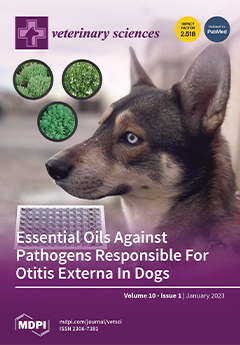A total of 1158 cats with feline upper respiratory tract infection were incorporated from twenty animal hospitals in Wuhan, China, from April 2019 to April 2022 to investigate the epidemiology of
feline calicivirus (FCV),
herpesvirus-1 (FHV-1),
Mycoplasma felis (
M. felis) and
Chlamydia felis (
C. felis) for the development of a geographically-specific FCV vaccine with reference to prevalence and risk factors for infection. The 871 samples (75.2%) of kittens were younger than 12 months, of which 693 were males, and 456 were females. Among the samples, 443 were British shorthair cats, accounting for 38.3%, and 252 were Chinese rural cats, accounting for 21.8%. PCR/RT-PCR detection of the above four viruses (FCV, FHV-1,
M. felis, and
C. felis) in the upper respiratory tract of cats showed that the total positive samples were 744 (64.3%), including 465 positive samples of
feline calicivirus, accounting for 40.2% of the total 1158 samples. There were 311 positive samples of
M. felis, accounting for 26.9% of the total samples, ranked second in clinical practice. The 180 positive samples of
feline herpesvirus accounted for 15.5%, and 85 positive samples of
Chlamydia felis accounted for 7.3%. Among them, the number of positive samples of single pathogenic infections was 493, accounting for 66.3% of the total 744 positive samples. Double, triple, and quadruple infections accounted for 28.2%, 5.0%, and 0.5%, respectively, with the highest proportion of single infections. The molecular biological characteristics of the 17 isolated FCVd strains in Wuhan were further analyzed. It was found that the F9 vaccine strain and the antigenic epitopes in the 5’HVR of the E region were collated with the F9 vaccine strain. Moreover, phylogenetic tree analysis showed that the strains related to the F9 and 255 vaccines were distantly related, leading to the failure of the vaccine. In addition, the strains associated with the F9 and 255 vaccines were distant, which might lead to vaccine failure in anticipation of the development of a more phylogenetically close FCV vaccine in China and may require the development of a vaccine for a locally related FCV strain.
Full article






